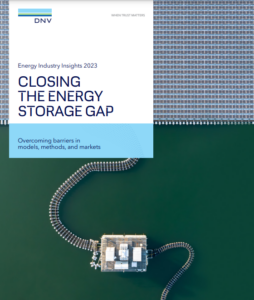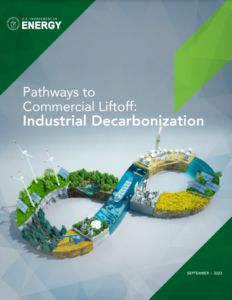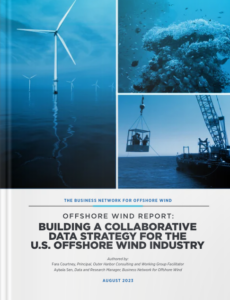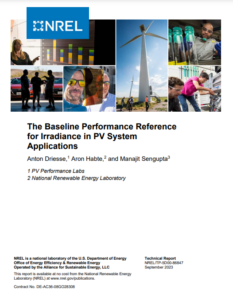The OurEnergyLibrary aggregates and indexes publicly available fact sheets, journal articles, reports, studies, and other publications on U.S. energy topics. It is updated every week to include the most recent energy resources from academia, government, industry, non-profits, think tanks, and trade associations. Suggest a resource by emailing us at info@ourenergypolicy.org.
Resource Library
Energy storage systems of various kinds are becoming increasingly important components of the emerging, decarbonized energy systems of the future. This research — which includes a specialist survey of over 400 senior executives with involvement in energy storage systems — reveals the extent and direction of current trends in this critical area. Most agree that to support electrification and decarbonization goals, we need to rapidly expand energy storage capacity and services. However, this expansion is hampered by several major barriers which are delaying progress towards cleaner, more resilient and more efficient energy systems.…
View Full ResourceIndustrial decarbonization presents a vital opportunity to transform industrial systems to improve energy and environmental justice. Today, U.S. industrial players are at risk of lagging behind net-zero targets, with a focus on short-term, easy-to-implement solutions; however, momentum is growing for deployment of industrial decarbonization solutions. The Bipartisan Infrastructure Law and Inflation Reduction Act have created unprecedented tools to support industrial decarbonization, customers are demanding low-carbon products (e.g., steel for auto), and early private sector movers are emerging. Achieving meaningful reductions could require up to $1,100 billion in capital expenditure and a bold shift in leadership and technology adoption across various …
View Full ResourceSub-Saharan Africa is uniquely positioned in the transition to a clean energy economy, as the region with the fastest-growing energy demand and lowest rate of access to reliable, clean, and affordable energy. Despite the substantial opportunity to improve lives and economies, there are flaws in the way we think and talk about energy in the region.
This brief identifies common misconceptions and gaps in research which need to be addressed for policy makers and investors to move forward with energy planning. Common myths of a uniform African continent and simplistic ideas of Africa’s abundant natural resources should be replaced by …
View Full ResourceThe Inflation Reduction Act (IRA) and the Infrastructure Investment and Jobs Act (IIJA) made some significant investments in industrial decarbonization, particularly for clean hydrogen and carbon capture, storage, and utilization. However, analyses show that the IRA does not adequately incentivize the full range of renewable thermal solutions. To accelerate the decarbonization of thermal energy for industry and buildings, the RTC has developed a set of recommendations for our advocacy efforts that build on the IRA and IIJA while addressing some critical policy gaps.…
View Full ResourceThe Business Network for Offshore Wind’s report, Building a Collaborative Data Strategy for the U.S. Offshore Wind Industry highlights the need for and benefits of developing a strategic, industry-wide approach to collecting and using data in the offshore wind sector. Authored by the Network’s Data & Digitalization Working Group (DDWG), the report outlines the positive impact a collaborative approach would have on offshore wind development in the U.S., making the case for widespread data sharing to increase efficiency industry-wide.
The U.S. industry has ramped up construction, recently celebrating steel in the water on the first two commercial-scale projects, and now …
View Full ResourceThe second report of the X-change series was produced by RMI in partnership with the Bezos Earth Fund and is a contribution to Systems Change Lab. These reports analyze the exponential growth of renewable energy technologies, demonstrating why and how major areas of the global energy system are achieving faster change than many realize.
In X-change: Cars, RMI shows that the rapid growth of electric vehicles (EVs) means that global oil demand for cars has already peaked and will be in freefall by 2030. The end of the internal combustible engine (ICE) age has begun.
There is a clear exponential …
View Full ResourceThis report proposes the definition of a new baseline performance reference (BPR). The definition goes beyond existing standards pertaining to photovoltaic (PV) reference cells and devices to define the response under all possible operating conditions in the field. Field evaluations using BPR devices will be more sensitive to performance anomalies than pyranometers because they track PV system power output more closely. At the same time, they will be able to detect a broader range of performance anomalies than traditional matched reference devices, which might have matching defects. The BPR definition also opens the door to new practices in resource assessment …
View Full ResourceCommunity solar (CS) projects often face uncertain interconnection costs and fees associated with distribution grid infrastructure upgrades required to connect the project.
These costs can determine the economic viability of a CS project, but they are difficult to assess. Cost uncertainty can discourage new projects and prevent communities from accessing the benefits of community solar projects. At the same time, CS deployment strategies hold potential to defer or avoid some distribution costs due to new loads.
This is the first analysis that has systematically studied the technical impacts of CS projects on a wide range of distribution feeders using state-of-the-art …
View Full ResourceThis report summarizes installed prices and other characteristics of grid-connected, distributed solar photovoltaic (PV) and PV+storage systems in the United States.…
View Full ResourceA large gap exists between the financing needed for the energy transition and what is being invested. Green bonds are flourishing as one of the main sources to close this financing gap, with over $2.5 trillion issued globally thus far. However, emerging market and developing economies (EMDEs) haven’t fully capitalized on the growth of this asset class: the share of EMDE (excluding China) green bonds denominated in local currencies within the total green bond universe remains minuscule. While some EMDE issuers can sell a bond denominated in dollars and hedge by swapping the dollar exposure into the local currency of …
View Full Resource








